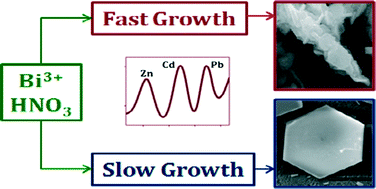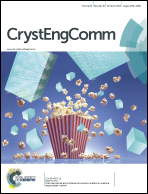Nano- and micro-hexagons of bismuth on polycrystalline copper: electrodeposition and heavy metal sensing†
Abstract
Hexagon-shaped bismuth nano- and micro-architectures have been electrodeposited onto polycrystalline copper electrodes from a nitrate bath at both constant current and constant potential conditions. Hexagonal geometries of varying sizes are obtained by tuning the deposition rate vis-à-vis that of a competing reaction, nitrate reduction. Nano-hexagons (100 nm to 1 μm) are obtained at 10 mA cm−2 when the HNO3 concentration is 0.2 M or less, and with 0.4 M HNO3, hexagons of sizes up to 20 μm are deposited. The obtained hexagons are polycrystalline. Further increase in nitric acid concentration results in fused sheet-like morphologies. Increasing bismuth concentration or reducing current density results in large crystallites. The ability of the obtained bismuth morphologies to detect ultratrace levels of lead has been studied. Only the nanohexagons and crystallites are able to detect lead at 1 ppb. The nanohexagons show good sensitivity to the detection of lead (LoD: 0.05 ppb or 0.24 nM; sensitivity: ~0.75 μA ppb−1) using Square-Wave Anodic Stripping Voltammetry (SWASV), and clearly distinct peaks for Pb2+, Zn2+, and Cd2+, indicating the potential for this morphology as an electrocatalytic material.


 Please wait while we load your content...
Please wait while we load your content...